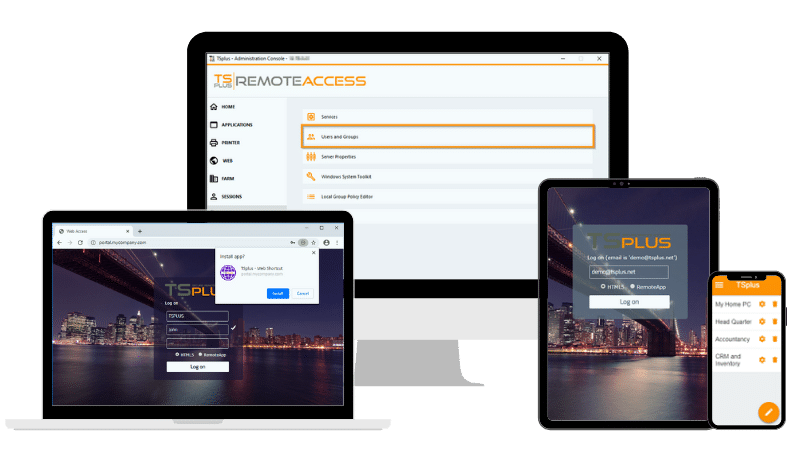)
)
What is the Remote Desktop Session Host?
The Remote Desktop Session Host (RDSH) is a server role within Microsoft's Remote Desktop Services that hosts Windows applications or entire desktops to be accessed by remote users. This central component plays a crucial role in the deployment of virtualized applications and desktops, providing access to these resources via a network connection. Below, we explore the key benefits and operational considerations for implementing RDSH.
Benefits of RDSH
Scalability
RDSH servers are designed to handle numerous simultaneous connections, making them suitable for both small businesses and large enterprises. The ability to support a high number of users on a single RDSH server simplifies the IT infrastructure and reduces the administrative overhead.
Cost Efficiency
Centralizing applications on RDSH servers allows organizations to extend the life of older hardware and reduce the costs associated with upgrades. Additionally, central management of applications can lower software licensing costs and IT support expenses.
Accessibility
RDSH enhances workplace flexibility by allowing users to access their applications and desktops from any location and any device with an internet connection, promoting productivity and supporting remote work policies.
Operational Considerations
Hardware Requirements
To effectively deploy RDSH, it is crucial to plan the server hardware specifications according to the expected load. This planning should consider CPU capabilities, RAM, and storage to ensure smooth operation and responsiveness of hosted applications and desktops.
Software Configuration
Installing the Windows Server operating system and enabling the RDSH role involves detailed configuration steps to optimize performance, security, and user access management. Proper setup of network settings, security policies, and session configurations are essential to leverage the full capabilities of RDSH.
By addressing these benefits and operational needs, IT professionals can ensure that their RDSH deployment enhances their organization's IT infrastructure while providing a scalable, cost-effective, and accessible solution for remote desktop access.
Implementing RDSH in Your IT Environment
Implementing the Remote Desktop Session Host (RDSH) requires a detailed approach to ensure that it integrates smoothly into an enterprise's IT infrastructure. Below, we outline the critical steps involved in setting up and configuring RDSH, publishing applications and desktops, and securing access.
Server Setup and Configuration
Initial Setup
Before deploying RDSH, it's essential to select and prepare the server hardware that meets the requirements for your expected workload. This includes adequate CPU power, RAM, and storage capacity to handle user sessions without performance degradation.
Operating System Installation
Install the Windows Server operating system on the server, ensuring it has the latest updates for security and stability.
Role Installation and Configuration
Enable the RDSH role via the Server Manager. This process involves adding the Remote Desktop Services role and configuring it to host applications and desktop sessions.
Application and Desktop Publishing
Publishing Applications
Identify the applications that need to be remotely accessible and configure them for remote access. This involves setting permissions and ensuring that they are optimized for remote delivery.
Configuring Desktops
For environments where full desktop access is necessary, configure the desktop experience settings. This includes setting up themes, wallpapers, and other user interface options to ensure a consistent user experience across remote sessions.
Security and Access Control
User Authentication
Set up secure authentication mechanisms to verify the identities of users accessing the RDSH server. This can include traditional methods like Windows Authentication or more secure options such as two-factor authentication with smart cards.
Connection Security
Implement RD Gateway to manage and secure remote connections to the RDSH server from outside the network. The RD Gateway uses SSL encryption to protect the data integrity and confidentiality of remote sessions
By following these detailed steps, organizations can ensure a robust and reliable RDSH deployment that provides high performance and secure access to remote applications and desktops.
Optimizing RDSH for Better Performance
Effective optimization of the Remote Desktop Session Host (RDSH) is crucial to maximize both system efficiency and user satisfaction. This section explores strategic optimization techniques, focusing on load balancing, resource management, and session management to enhance the performance and reliability of the RDS environment.
Load Balancing with RD Connection Broker
Purpose of Load Balancing
Load balancing is essential to distribute user sessions and workloads evenly across multiple RDSH servers, preventing any single server from becoming overwhelmed. This balance helps maintain service continuity and optimizes resource use.
Implementing with RD Connection Broker
RD Connection Broker manages the distribution of user sessions among available RDSH servers based on current load and server capacity. Configuring the RD Connection Broker involves setting connection rules and parameters that define how sessions are distributed, ensuring even load distribution and optimal resource utilization.
Resource Management
CPU, Memory, and Storage Allocation
Appropriate allocation of resources is paramount in maintaining an efficient RDSH environment. Each server’s CPU, memory, and storage should be configured based on the specific needs of the applications it hosts and the number of users it supports.
Optimizing Application Performance
Adjust resource allocation dynamically to meet changing demand and ensure high performance for critical applications, especially during peak usage times.
Session Management
Managing User Sessions
Implement policies that govern session timeouts and automatic reconnection. These policies help manage the load on the RDSH servers by freeing up resources occupied by inactive sessions and efficiently reconnecting users when they return.
Enhancing User Experience
Session management should aim not only to preserve system resources but also to provide a seamless user experience. Strategies include prioritizing resources for active sessions and using session pre-launch techniques to reduce login times.
These optimization strategies are designed to enhance the overall performance of the RDSH environment, ensuring it meets the demands of modern enterprise applications and their users. By focusing on strategic resource allocation and efficient session management, IT administrators can significantly improve the responsiveness and reliability of their RDS deployments.
TSplus Solutions
TSplus understands the challenges of managing RDS environments and offers a comprehensive solution that enhances the capabilities of traditional RDS setups. Our software provides a cost-effective, scalable, and user-friendly alternative to complex deployments, simplifying management and extending functionality.
For IT professionals looking to enhance their RDS capabilities, TSplus offers tools and features that integrate seamlessly with existing systems, providing enhanced security, reliability, and performance. Visit our website to learn more about how TSplus can help optimize your RDS environment.
Conclusion
Effective deployment of RDSH ensures scalable, cost-efficient, and accessible remote desktop services that meet the needs of modern businesses. By carefully planning server setup, application deployment, security measures, and performance optimization, IT professionals can create a robust RDS environment that enhances productivity and provides a seamless user experience. As organizations continue to embrace remote and hybrid work models, leveraging the power of RDSH with TSplus solutions will be crucial in achieving efficient and secure application and desktop delivery. For more on how TSplus can help optimize your RDS setup, visit our website.

TSplus Remote Access Free Trial
Ultimate Citrix/RDS alternative for desktop/app access. Secure, cost-effective, on-premises/cloud














)
)
)